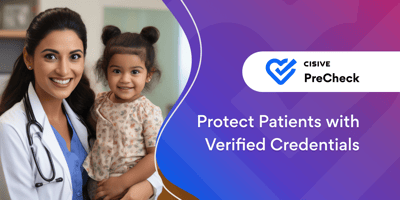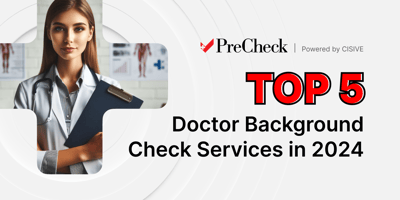

Every hospital wants only qualified, verified providers delivering patient care, which makes the...

Provider credentialing is essential. Healthcare organizations must have bylaws in place that define medical credentialing requirements to remain in compliance and ensure the providers have the qualifications they claim to have.
The credentialing process involves gathering large amounts of information and documentation from the provider and verifying it. Then, your organization checks with various organizations to ensure those credentials are valid and current.
Verification includes background checks, employment verifications, exclusion screenings, and other checks.
Completing the process correctly is key to finding qualified providers. It ensures they can provide the kind of high-quality care your patients expect.
Explore our provider credentialing checklist to improve your processes.
Key TakeawaysHere's what you need to know about provider credentialing:
|
Healthcare provider credentialing is a structured process used to verify that a provider has the qualifications and credentials to perform the job. It's a vetting process that confirms the provider can legally and competently perform the job duties.
Credentialing is often detailed and complex to ensure the person meets requirements set by accrediting bodies, third-party payors, and other stakeholders. All credentialing must be completed before a provider can start working at a healthcare organization.
A provider credentialing checklist typically includes a wide range of qualifications for the position. The specific qualifications vary based on the type of medical position and the specialty of the provider.
Provider credentialing ensures the individual has the skills and competencies to handle the position and deliver quality patient care. It's imperative for patient safety and your organization's reputation.
Proper credentials are required to maintain regulatory compliance, which helps you avoid fines or legal consequences for employing an unqualified person. You also need to hire properly credentialed employees to ensure you receive insurance reimbursements without issue.
Looking at examples of provider credentialing can help you better understand the process.
The provider credentialing process may vary based on the organization and the purpose of credentialing. However, many of the steps are similar regardless of the purpose.
Several steps are involved in provider credentialing, including:
Employers need to collect supporting documentation to ensure the provider meets the minimum qualification requirements. Some examples of documentation to include in your provider credentialing checklist include:
Provider credentialing can take anywhere from 30 days to 6 months to complete. Starting as soon as possible minimizes delays.
Providing thorough instructions gives applicants the information they need to complete the application accurately. Lack of information or incorrect completion could slow down the process.
It's also helpful to communicate clearly, respectfully, and promptly with all involved parties. This ensures everyone has the correct information and understands the urgency of the situation.
State and federal regulations require credentialing to ensure compliance and verify the provider's qualifications. You lower potential financial liabilities due to noncompliance by having strict credentialing processes in place.
Checking qualifications also ensures the provider knows how to perform the essential tasks of the job safely. This increases the quality of patient care and reduces the risks of malpractice cases for your organization due to harm caused by an unqualified provider.

It's crucial for your healthcare organization to have provider credentialing processes in place. The following tips improve your results to ensure you're hiring the best providers.
It can take months to verify all a provider's credentials, and the process must be completed before the individual begins working at your facility.
Starting the verification process early helps to streamline the process and allow time for additional information gathering, when necessary.
Looking for a provider’s name on exclusion lists can save you time. If the provider appears on an exclusion list, they're prohibited from providing patient care if your organization received funds from federal programs, such as Medicare and Medicaid.
Exclusion and sanction monitoring could eliminate providers early in the credentialing process if you rely on funding from federal programs. It's not worth your time to check their other credentials if the exclusion would disqualify them for the position.
Documentation is essential for compliance and backing up your decisions. You're required to complete provider credentialing to meet regulations, and your documentation proves that you followed those steps.
If you must withdraw a job offer due to issues that arise during credentialing, you have evidence that supports this decision. This information may be necessary if the provider accuses you of unfair treatment or tries to challenge the decision.
The documentation can also become a part of the individual’s file if they pass the credentialing process. If a performance issue arises in the future, you can look back at that documentation to show due diligence.
Because it's a lengthy process, it's helpful to track your progress. Having a provider credentialing checklist makes it easier to keep track of where you are in the process.
Include checkboxes to show that a task was completed. You can also add completion dates for each step to monitor the efficiency of your process and have a record of when a step was completed.
Regulatory agencies determine what type of information you need to verify before a new provider starts working with patients. Failing to follow those regulations could result in financial or legal repercussions for your organization.
Ensure you know the required processes for the position based on those regulations, such as compliance for background checks. Keep current on any changes to the requirements to determine if you need to update your credentialing processes.
Effective and consistent communication can help the credentialing process go smoothly. Letting the provider know what they need to provide prevents delays and ensures you get the information you need to complete the process efficiently.
You also need to communicate well with other organizations as you contact them to verify the person's credentials. Research the proper contact channels to save time.
Several software programs and services are available to help with background screening and credential verification. Choosing the right program is essential.
Background screening programs, such as PreCheck, follow industry regulations and help you maintain compliance. You also get reliable results in one comprehensive dashboard where you can collect all relevant information about your employees.
PreCheck also offers other services, including immunization tracking and healthcare license monitoring, allowing you to monitor your employees with one central dashboard.
Conducting screenings and verifications manually is a time-consuming task that can delay the hiring process for healthcare professionals. PreCheck and other similar background check services automate many of the processes, providing accurate results for all types of checks, including student background checks and drug and occupational health testing.
Programs designed specifically for healthcare offer targeted search options and provide the details you need to meet healthcare regulations. These programs save you time and money while helping you avoid problems, such as issues with background check compliance in healthcare.
Thorough provider credentialing protects your organization from compliance issues and increases the quality of care you provide to patients. PreCheck simplifies the process and helps you complete your provider credentialing checklist efficiently.
Contact one of our PreCheck experts for a demo and to learn more about how it can support your credentialing process.
Author: Brent Gibbons
Bio: Healthcare Screening Expert at Cisive PreCheck.
Let's Connect on LinkedIn
Every hospital wants only qualified, verified providers delivering patient care, which makes the...

As a Medical Staff Professional, you know how important it is to vet providers thoroughly. After...

Before you hire a physician, you must conduct a thorough background check as part of the...